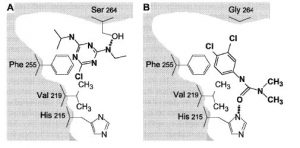Chapter 19: MOA Part 4 – Photosynthesis Inhibitors (Photosystems)
19.5 Herbicide Resistance to Photosystem II Inhibitors
Herbicide Design
Interestingly, the triazines were first commercialized in 1958. Biochemists have put much effort into the design of the Photosystem II inhibiting herbicides. Since the mode of action involves competition for a binding site within a membrane environment, the effectiveness of the herbicide will be greatly affected by small changes in its structure.
For example, there is described Site A and Site B herbicide binding areas of the D1 protein. As a result, unlike some of the other herbicides, there is no cross-resistance within this site of action. Looking carefully at this diagram, you can see that atrazine (Group 5) binds to the “Ser 264” aminio acid of D1 (Site A). In contrast with Site B, Diuron (Group 7), binds in a different amino acid location, to “Hist 215”.

Therefore, small modifications in the molecular structure of a herbicide may cause differential sensitivity in different species of plants. As seen in the diagram, the D1 protein in different plant species will have slightly different sequences of amino acids making differential effectiveness possible with the same herbicide molecule. Plants also have detoxification systems that may greatly affect the response of different crops to herbicides.
For example, corn is relatively insensitive to atrazine because it has an efficient detoxification system involving reaction with glutathione, a protective tripeptide, and transport to the cell’s vacuole.
Herbicide Resistance
At the time this chapter was published, herbicide resistance in different weeds species in the US and globally had been reported to the Photosystem II Inhibitors. The US resistance weeds described were:
- Group 5 (C1): 26 different weed species, including Velvetleaf (Abutilon theophrasti), Smooth Pigweed (Amaranthus hybridus (syn: quitensis)), Palmer Amaranth (Amaranthus palmeri), Redroot Pigweed (Amaranthus retroflexus), Tall Waterhemp (Amaranthus tuberculatus (=A. rudis)) and Common Lambsquarters (Chenopodium album).
- Group 6 (C3): 1 weed species, Common Groundsel (Senecio vulgaris)
- Group 7 (C2): 9 different weed species, including Blackgrass (Alopecurus myosuroides) in 1979, Redroot Pigweed (Amaranthus retroflexus) and Kochia (Kochia scoparia).
For the latest updated information on herbicide resistance, see The International Survey of Herbicide Resistant Weeds, a collaborative effort between weed scientists in over 80 countries, located at www.weedscience.org.